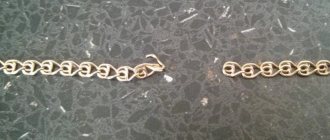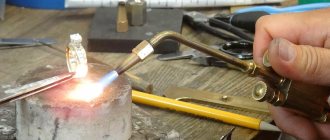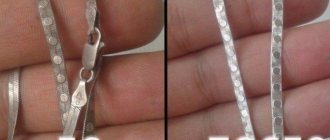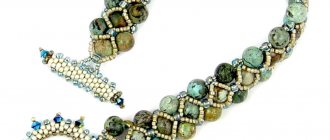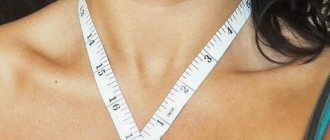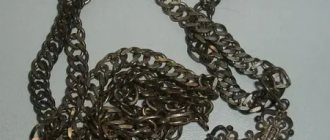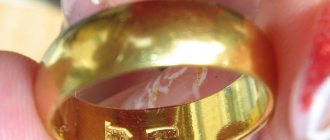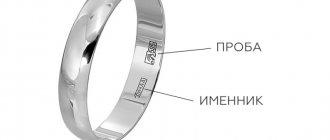Unfortunately, it happens that your favorite piece of jewelry breaks at the clasp and only a qualified craftsman can fix it. When repairing a carabiner on a chain or bracelet in our jewelry workshop in Moscow, experienced specialists not only repair the existing damage, but can also select a clasp of the appropriate size and design.
A carabiner is usually installed on a massive chain, as it is particularly durable and securely fastened. This product is assembled by hand and is very convenient to use. However, it is worth remembering that it is not always possible to repair a carabiner on a chain, since if the spring mechanism breaks, the lock must be replaced. If the breakdown is quite complex, then the client independently decides whether to carry out repairs or replace the carabiner on the chain with a new one. Our company offers you the following services:
- carrying out repair work and restoration of jewelry;
- production of products to order;
- engraving and much more.
The cost of replacing the spring on a gold chain carabiner is 400 rubles, and on a silver one – 300 rubles. We perform laser soldering using the most innovative technologies, which allows us to complete everything as accurately, efficiently and quickly as possible. In addition, if the client wishes, we can custom make a clasp of an unusual type, give it an unusual shape and make it stylish. Such a product will emphasize the individuality of the decoration and will be easily recognizable.
How to repair or solder a gold or silver chain at home
If worn continuously, hollow or defective, gold and silver chains may break or become deformed. And problems arising in the locking mechanism can lead to loss of the product. How to repair a gold or silver chain at home and what is needed for this? Is it possible to repair a broken chain so that the break point is invisible?
Repair of lock in jewelry, Podol. Jewelry workshop in Kyiv “Ametist”, Center, Kyiv
Repairing a lock on a piece of jewelry , in particular repairing a lock on a chain in Kiev or repairing a lock on a bracelet in Kiev is one of the types of repairing jewelry chains or repairing bracelets, which is carried out in our jewelry workshop in Kiev “Ametist” . Jewelry chains and bracelets are the most common jewelry that each of us probably has. They can be gold, silver, jewelry, or consist of different metals. Also, jewelry chains and bracelets come in different weaves, and can be solid or hollow (they have become popular recently due to their low weight). Chains are usually worn every day. Therefore, they are prone to frequent breakdowns. One of the parts that is very often the first to break is the lock.
How to solder a chain at home
Repairing a silver chain with your own hands is a filigree and responsible job. It is necessary to have equipment, a set of reagents and, most importantly, skills to work with them. Otherwise, you can damage the product, and instead of restoring it, disfigure it. If the required equipment and reagents are not available and this type of work is new, it is better to abandon the intention of soldering a silver chain at home, and leave this work to a specialist from a jewelry workshop. The same applies to repairing a gold chain.
Basic concepts and definitions
Before you begin repair work on silver or gold, it is important to have a set of necessary materials:
- Solder is a special metal alloy that has a melting point lower than pure metal.
- Flux is a mixture or single substance of an organic or inorganic nature that promotes uniform distribution of solder over the surface and prevents oxidation of the metal when heated.
- An acid solution (not to be confused with acid flux) brightens the metal after soldering.
How to solder a silver chain
Depending on the standard of the silver jewelry, the brand of solder is selected, which is produced in the form of rods, pieces, etc. An equally important characteristic of the auxiliary alloy is its fluidity and hardness.
Silver solder consists of silver, zinc and copper, and may include tin. The higher the silver content in the alloy, the stronger the soldering will be. The melting point of solder ranges from 640 to 780 °C, while the melting point of pure silver is 961 °C.
Soldering a silver chain at home involves several stages.
- Using any fireproof material (brick, asbestos), securely fasten the parts of the product.
- Treat the joints with flux and put solder between them.
- Carefully heat the metal evenly until a soldering seam is formed (try to solder the silver chain so that the seam is strong and at the same time invisible).
- Cool the product, remove flux and solder, then polish.
- To lighten the soldering area, treat it with an acidic solution, such as nitric acid.
It is possible to solder a silver chain at home with a soldering iron yourself, using special solder combined with flux.
Is it possible to solder a gold chain?
At home, it is possible to solder a gold chain in the same way as described above, using gold solder. It contains gold, silver, copper, zinc and in some alloys cadmium. The melting point of solder ranges from 710 to 850 °C, while that of pure gold is 1063 °C.
It is important to understand that repairing a gold chain by a non-specialist, even with the necessary materials, is quite difficult. Therefore, the best way out of the situation is to use the services of jewelry repair specialists.
The lock on the chain is broken: how to fix it
There are mainly 3 types of locks used in jewelry:
- carabiner, in which the pin or spring may break;
- springel - practically cannot be repaired, only replaced with a new one;
- box - the tongue or insurance breaks.
It is easy to repair a lock on a chain with your own hands if its individual parts are not broken, but somewhat deformed, for example, in the case of a box lock. You just need to press a little and return them to their previous position. You can repair the carabiner by replacing the pin or spring (if available).
You can make a clasp on a gold or silver chain yourself, just by replacing it with a new one. In other cases, it is better to repair the clasp on the chain in a jewelry workshop. The specialist will select the necessary spare parts and regulate their interaction during installation.
Can I return jewelry to the store?
Repair your old lock, or replace the entire lock. We have a large selection of gold, silver and jewelry locks, as well as carabiners, box locks, spring locks, federated locks, screw locks and pin locks.
By law, a jewelry salon does not have the right to refuse to exchange or pay the entire purchase price, but not in all cases. At the initiative of the buyer, it is more expedient to carry out an examination already in court proceedings. The seller considers the claim within 10 days.
If the identified defects arise as a result of a defective product, the store is obliged to return the full cost of the jewelry to the buyer.
Any mechanical impact can lead to premature wear and tear of the jewelry. Do-it-yourself or professional repair?
But still, you can refuse such a product and return the money or ask for an exchange, but for this the product must have a manufacturing defect or defect, for example, scratches, chips, cracks and other visible effects were found on the silver product that did not arise due to the fault of the buyer, or the product has torn or burst a link or fastener without external mechanical intervention.
And a gold chain can be easily stretched, depending on the weave. We were going to give a chain to the little one, but the sellers talked us out of it - either a thick chain at around 7 rubles for a 40cm thing, or none at all, since children would tear them apart. The child could easily get caught and pull. So, unfortunately, you will have to repair it immediately at your own expense.
But there is another law that consumers are not always aware of: “gold jewelry cannot be returned or exchanged.” It states that jewelry can be returned only in case of a manufacturing defect, the fact of which must be proven. A! Well, then this turns out to be a completely different situation! The girls could have gotten caught somewhere and pulled hard. It depends on the weave of the chain and the thickness of the links. I have a chain, just like that, it stretched in separate small links and then finally broke in one place, but the little one loved to pull it with all his might.
What to do if the chain is stretched
Since silver and gold are soft metals, the weave can stretch out if not handled carefully. First of all, this applies to products made from low-quality alloys or with complex filigree weave. Under severe external influence, a stretched silver chain or gold weave becomes irreversibly deformed.
Heavy gold chains in the Sunlight catalog
If a gold chain of simple weaving has stretched, you can independently remove some of the “extra” links to the previous length. If the weaving is complex and multifaceted, then regardless of the material, it is better to seek the help of a specialist.
Gilding, rhodium plating and enamel
| Type of work | Metal | Price |
| Yellow coating (pre-polishing of the product is included) | from 700 rub | |
| Red coating (pre-polishing of the product is included) | from 700 rub | |
| White coating - rhodium (pre-polishing of the product is included) | from 700 rub | |
| By silvering the product | NO | |
| Hot enamel (good color and strength) | from 2800 rub | |
| Cold enamel (worse color and strength lower than hot enamel) | from 1200 rub |
We do not deal with coating of products made from non-juteric metals.
Source
Repair and replacement of locks on chains, earrings and bracelets
Beautiful jewelry can make even the simplest look bright and interesting. Therefore, it is not surprising that many modern people quite actively use gold and silver items, both in everyday life and on holidays. But sometimes you have to look for the answer to the question of how to fix it if the lock on the chain is broken?
- Main types of chain locks
- Locks for jewelry chains and bracelets: which one breaks more often
- How to solder a silver chain: restoring jewelry at home
Why do silver chains break? Top 3 reasons
- Defective product. But the store will not simply accept a broken chain back: an examination must be carried out to prove a manufacturing defect. If the examination confirms that the manufacturer is at fault, then the buyer will return the money spent - both for the decoration and for the examination.
- Hollowness. Yes, chains are often made hollow - this is not very practical, but it reduces the cost of decoration. Heavy pendants cannot be hung on such chains, and they can also break from the slightest mechanical impact.
- Wearing heavy pendants. To avoid putting too much stress on the chain, consider the weight ratio of the chain to the pendant.
Why do locks on chains and earrings break?
Not everyone knows that repairing or replacing a lock on a chain is a quick and not very difficult operation if a master gets to work. Professional repair of locks on jewelry requires special equipment, optics, a laser welding machine, and consumables. If you do not want to part with your favorite jewelry, the jewelers of the ArtBazar workshop in the center of Rostov-on-Don will quickly repair or replace the lock on a chain, bracelet or earrings in your presence. The lock on a chain, earrings or bracelet, regardless of its type and complexity of manufacture, must function correctly so that there is no risk of losing the jewelry. A working lock on a chain fastens and unfastens smoothly, effortlessly, and closes tightly. Unfortunately, due to frequent use or careless handling, the chain lock mechanism wears out, begins to jam, or does not close completely. If you do not immediately send your jewelry for repair, it may break completely or even slip off unnoticed and get lost. If you notice that the lock on the chain does not work the first time, jams, or does not work as well as before, it is better to immediately bring the jewelry to a jewelry repair shop and find out whether the lock needs to be repaired, replaced, or just have the jewelry professionally cleaned.
Earring repair
| Type of work | Metal | Price |
| Replacement - needle repair (Including metal) | Silver | from 450 rub |
| Needle replacement/repair (Excluding metal) | Gold | from 450 rub |
| Thread cutting for studs | from 250 rub. | |
| Making the back element of the earring fastener (English lock) (excluding metal) | from 1200 rub | |
| Making a twist for a stud (excluding metal) | from 1200 rub | |
| Editing a needle in English lock (to improve fixation) | For free | |
| Prices vary depending on the complexity of the product, as well as the presence of rare and precious stones in them | guarantee | 12 months |
Remember! that all earrings have their own unique shapes and therefore it will simply be impossible to announce the exact price for repairs without showing the product to the master..
Types of jewelry lock failures
Locks on chains, earrings and bracelets come in different types of fastening. Different types of locks on jewelry have different types of breakdowns.
The following types of locks are usually found on gold and silver jewelry:
- carabiner, in the form of a loop with a tongue, they often have to change the pin or spring;
- springel, in the form of a thin hollow ring with a bent rod, they are more often replaced than repaired;
- lock-boxes, the tongue and insurance break in them.
The most popular repairs are locks on chains and bracelets. These jewelry are worn every day and are subject to stress and stretching. Even such a reliable type of chain lock as a carabiner will eventually break.
Box locks on bracelets have additional insurance, but such locks also have to be repaired by soldering or replaced with new ones. Earring locks break less often. Reliable earring locks with screw locks, spring locks and English locks are still not immune to breakage. Masters of the ArtBazar jewelry repair workshop in Rostov repair and replace locks on gold and silver chains, bracelets, earrings of any type and any complexity.
Chain locks break in different ways. What most often happens to chain locks:
- chain links are broken;
- the connecting lugs in the chain lock are worn out;
- a small spring in the lock broke;
- The hook has worn out.
There are also other defects and breakages of locks on chains, earrings and bracelets.
Ring repair
| Type of work | Metal | Price |
| Increasing or decreasing the ring by one size (Regular shape) | Silver | from 300 rub. |
| Increasing or decreasing the ring by one size (Regular shape) | Gold | from 350 rub. |
| Increasing or decreasing the ring by one size (Unusual shape) | Silver | from 450 rub |
| Increasing or decreasing the ring by one size (Unusual shape) | Gold | from 650 RUR |
| Editing the ring (reshape it back) | Silver | from 100 rub |
| Editing the ring (reshape it back) | Gold | from 250 rub. |
| Grinding, polishing (removing scratches and adding shine) | Silver | from 250 rub. |
| Grinding, polishing (removing scratches and adding shine | Gold | from 350 rub. |
| Prices vary depending on the complexity of the product, as well as the presence of rare and precious stones in them | guarantee | 12 months |
Remember! that all rings have their own unique shapes and therefore it will simply be impossible to announce the exact price for repairs without showing the product to the master.
Why you shouldn’t repair chain locks yourself
Sometimes people think that sending jewelry for repairs is expensive and time-consuming. Someone tries to repair a lock on a chain with their own hands or stops wearing jewelry. On the Internet you can find instructions on how to repair a lock on a chain or earrings yourself. In fact, it is better not to repair locks on expensive jewelry yourself. As a result of rough manipulations, you can break the jewelry, reduce the weight of the valuable metal in the product, reduce its price, and make the repair site visible to the eye. All this is unacceptable in relation to jewelry. Moreover, repairing locks on chains, bracelets and earrings in the ArtBazar jewelry workshop in Rostov is quite inexpensive and is done in the shortest possible time.
Other types of work
| Type of work | Metal | Price |
| Stone setting | from 70 rub. | |
| Pasting pearls | from 70 rub. | |
| Setting stones | from 70 rub. | |
| Beading | from 500 rub | |
| Glasses repair (laser) | from 700 rub | |
| Soldering metal in worn areas (helps prevent product rupture and loss) | from 350 rub. |
There may be other types of work that we simply forgot to mention here. So contact us and we will try to help all our clients.
Clasps (clasps) for jewelry
1) Size of jewelry: small clasps will look neat in miniature jewelry; large clasps are better suited for massive jewelry.
2) Weight of jewelry: for heavy jewelry, for example, from large stone or porcelain beads, it is better to select the most reliable fasteners, such as carabiners, sliders, toggles, and some types of hooks.
3) Number of rows in the decoration: for multi-row or wide decorations, you should choose clasps with several loops or use adapter connectors.
4) Type of decoration: almost all types of clasps are suitable for neck jewelry, but for bracelets it is better to use more reliable clasps that will not unfasten on their own when your hand rubs against clothes or other objects. In addition, for bracelets it is better to use clasps that you can unfasten or fasten yourself while putting on the bracelet. Despite such limitations, you can choose a suitable clasp for a bracelet in almost any type of clasp - the main thing is to take into account all other factors. In our opinion, the most convenient clasps for bracelets are toggles, sliders, strong magnetic clasps, carabiners (if you get the hang of fastening them yourself).
5) Ease of use: when assembling jewelry, you must take into account the fact who will wear this jewelry. For people with low vision and impaired fine motor skills (for example, older people), it is better to use large, easy-to-fasten/unfasten clasps. For small children, it is better, on the contrary, to use clasps that are difficult to unfasten on their own - this reduces the likelihood that the decoration will be lost.
6) Does the length of the jewelry need to be adjusted: if the jewelry is made for sale, it is better to install a clasp that allows you to change the length of the jewelry, for example, by using an extension chain. Such fasteners include: carabiners, rings, hooks, snap fasteners. If the jewelry is created for a specific person, you can make the jewelry of a fixed size and use any type of clasp. Note that all types of fasteners can be used for transformable jewelry that has variable length. Even if the clasp does not have the possibility of extension (it consists of two parts that can only close on each other), you can make a decoration with several such clasps. That is, the decoration will consist of several parts, each of which can be fastened either on its own or attached to another part of the decoration. In this way, you can make beads/necklaces that can change length, or a bracelet and necklace that can be worn as a set, or can be clasped together and worn as long beads, as shown in the photo below:
7) Decoration design: of course, when choosing a clasp, you should definitely take into account the design of the decoration. The clasp should not stand out from the overall style of the decoration or draw attention to itself (unless, of course, it is the central element of the decoration).
In some cases, you can do without a fastener. For example, when assembling jewelry using an elastic band, memory wire, or when creating long beads worn over the head or tied in a knot. On bracelets woven from cords, the clasp can be replaced with a slip knot or a button clasp. Wide textile or leather bracelets can be laced. Examples of jewelry created without the use of clasps are presented below:
And finally, let’s consider non-standard options for using fasteners. For example, carabiners are often used to decorate keychains, bracelets, bookmarks, and sometimes earrings with pendants: the carabiner pendant can be easily detached and replaced with another, which makes the jewelry/accessory more versatile. Toggles themselves are sometimes used as pendants, and this applies to both rings and toggle sticks. Below are examples of the use of fasteners “not for their intended purpose”:
Please answer. The lock on my gold chain broke.
The seller must inform you about the terms of the guarantee; if this was not done, then you have the right to present your claims to the seller within a reasonable time, but not more than 2 years.
Article 18. Consumer rights when defects are discovered in a product
(as amended by Federal Law dated October 25, 2007 N 234-FZ)
1. If defects are discovered in a product, if they were not specified by the seller, the consumer has the right, at his own discretion, to:
demand replacement with a product of the same brand (same model and (or) article);
demand replacement with the same product of another brand (model, article) with a corresponding recalculation of the purchase price;
demand a proportionate reduction in the purchase price;
demand immediate free elimination of defects in the goods or reimbursement of costs for their correction by the consumer or a third party;
refuse to fulfill the purchase and sale agreement and demand a refund of the amount paid for the goods. At the request of the seller and at his expense, the consumer must return the defective product.
In this case, the consumer also has the right to demand full compensation for losses caused to him as a result of the sale of goods of inadequate quality. Losses are compensated within the time limits established by this Law to satisfy the relevant consumer requirements.
In relation to a technically complex product, if defects are discovered in it, the consumer has the right to refuse to fulfill the purchase and sale agreement and demand a refund of the amount paid for such a product or make a demand for its replacement with a product of the same brand (model, article) or with a different product. brand (model, article) with a corresponding recalculation of the purchase price within fifteen days from the date of transfer of such goods to the consumer. After this period, these requirements must be satisfied in one of the following cases:
detection of a significant defect in the product;
violation of the deadlines established by this Law for eliminating product defects;
the impossibility of using the product during each year of the warranty period in total for more than thirty days due to repeated elimination of its various deficiencies.
The list of technically complex goods is approved by the Government of the Russian Federation.
(Clause 1 as amended by Federal Law dated October 25, 2007 N 234-FZ)
2. The requirements specified in paragraph 1 of this article are presented by the consumer to the seller or an authorized organization or an authorized individual entrepreneur.
(as amended by Federal Law dated December 21, 2004 N 171-FZ)
3. The consumer has the right to present the requirements specified in paragraphs two and five of paragraph 1 of this article to the manufacturer, authorized organization or authorized individual entrepreneur, importer.
(as amended by Federal Laws dated December 21, 2004 N 171-FZ, dated October 25, 2007 N 234-FZ)
Instead of presenting these demands, the consumer has the right to return goods of inadequate quality to the manufacturer or importer and demand a refund of the amount paid for it.
(as amended by Federal Law dated October 25, 2007 N 234-FZ)
4. Lost power. — Federal Law of October 25, 2007 N 234-FZ.
5. The consumer’s absence of a cash or sales receipt or other document certifying the fact and conditions of purchase of the goods is not a basis for refusal to satisfy his requirements.
The seller (manufacturer), authorized organization or authorized individual entrepreneur, importer are obliged to accept goods of inadequate quality from the consumer and, if necessary, carry out a quality check of the goods. The consumer has the right to participate in checking the quality of the product.
(as amended by Federal Law dated December 21, 2004 N 171-FZ)
In the event of a dispute about the reasons for the occurrence of defects in the goods, the seller (manufacturer), an authorized organization or an authorized individual entrepreneur, or the importer are obliged to conduct an examination of the goods at their own expense. The examination of goods is carried out within the time limits established by Articles 20, 21 and 22 of this Law to satisfy the relevant consumer requirements. The consumer has the right to be present during the examination of the goods and, in case of disagreement with its results, to challenge the conclusion of such examination in court.
(as amended by Federal Law dated October 25, 2007 N 234-FZ)
If, as a result of the examination of the goods, it is established that its defects arose due to circumstances for which the seller (manufacturer) is not responsible, the consumer is obliged to reimburse the seller (manufacturer), an authorized organization or an authorized individual entrepreneur, the importer for the costs of conducting the examination, as well as those associated with its implementation. costs of storing and transporting goods.
(as amended by Federal Law dated December 21, 2004 N 171-FZ)
(Clause 5 as amended by Federal Law dated December 17, 1999 N 212-FZ)
6. The seller (manufacturer), authorized organization or authorized individual entrepreneur, importer is responsible for defects in goods for which there is no warranty period, if the consumer proves that they arose before the transfer of the goods to the consumer or for reasons that arose before that moment.
(as amended by Federal Law dated December 21, 2004 N 171-FZ)
In relation to goods for which a warranty period has been established, the seller (manufacturer), an authorized organization or an authorized individual entrepreneur, the importer is responsible for defects in the goods unless he proves that they arose after the goods were transferred to the consumer as a result of the consumer’s violation of the rules for use, storage or transportation of the goods, actions of third parties or force majeure.
(as amended by Federal Law dated December 21, 2004 N 171-FZ)
(Clause 6 introduced by Federal Law dated December 17, 1999 N 212-FZ)
7. Delivery of large-sized goods and goods weighing more than five kilograms for repair, markdown, replacement and (or) return to the consumer is carried out by and at the expense of the seller (manufacturer, authorized organization or authorized individual entrepreneur, importer). In case of failure to fulfill this obligation, as well as in the absence of the seller (manufacturer, authorized organization or authorized individual entrepreneur, importer) at the consumer’s location, delivery and (or) return of these goods may be carried out by the consumer. In this case, the seller (manufacturer, authorized organization or authorized individual entrepreneur, importer) is obliged to reimburse the consumer for expenses associated with the delivery and (or) return of these goods.
(Clause 7 as amended by Federal Law dated December 21, 2004 N 171-FZ)
Sincerely,
Call
Did the answer help you? Yes No
Where to repair a lock on a gold or silver chain in Rostov
Jewelers from the ArtBazar workshop perform quality and professional repairs and replacement of locks on jewelry, clean and adjust locks. At the same time, you receive free advice on caring for your jewelry so that your chains and earrings do not break for as long as possible. Most often we have to carry out the following types of repairs on locks of chains, earrings and bracelets:
- solder chain links when broken by placing one end on the other;
- solder a torn or frayed ear by adding metal or narrowing the hole;
- make a new ear instead of a broken one;
- unsolder and insert a new spring instead of a broken one into the lock of the product.
In some cases, we use laser welding to restore parts of jewelry locks and to secure new clasps. In this case, the seam remains invisible and the metal is not damaged. If the lock on a chain, earrings or bracelet breaks, bring the jewelry to the ArtBazar jewelry workshop in the city of Rostov. We will quickly, efficiently and inexpensively repair or replace jewelry locks of any complexity.
Repair of chains and bracelets
| Type of work | Metal | Price |
| Soldering one place in a simple weave (let's say soldering a broken chain link) | Silver | from 250 rub. |
| Soldering one place in a simple weave (let's say soldering a broken chain link) | Gold | from 350 rub. |
| Soldering one place in a complex weave (hollow) | Silver | from 350 rub. |
| Soldering one place in a complex weave (hollow) | Gold | from 450 rub |
| Soldering one place of the product with a laser (almost any weaving can be soldered) | Silver | from 450 rub |
| Soldering one place of the product with a laser (almost any weaving can be soldered) | Gold | from 550 rub. |
| Soldering one place of the product with a laser (almost any weaving can be soldered) | Bijouterie | from 450 rub |
| Repair of a pin in a chain or bracelet (if there is a large number of replacement pins in a product, the price is reduced) | Silver | from 450 rub |
| Repair of a pin in a chain or bracelet (if there is a large number of replacement pins in a product, the price is reduced) | Gold | from 650 RUR |
| Repair of a pin in a chain or bracelet (if there is a large number of replacement pins in a product, the price is reduced) | Bijouterie | from 450 rub |
| Repairing a spring or replacing a lock - carabiner (price depends on the size of the lock) | Silver | from 300 rub. |
| Repairing a spring or replacing a lock - carabiner (price depends on the size of the lock) | Gold | from 350 rub. |
| Repair of springs in a round lock - Springel (cannot be repaired! replacement only) | Silver | from 250 rub. |
| Repair of springs in a round lock - Springel (cannot be repaired! replacement only) | Gold | from 350 rub. |
| Reducing the length of a chain or bracelet (basically 2 solders) | Silver | from 450 rub |
| Reducing the length of a chain or bracelet (basically 2 solders) | Gold | from 550 rub. |
| Adding links to a chain or bracelet (depending on the weave) | Negotiable | |
| Cleaning and polishing a chain or bracelet (depending on the weave) | Negotiable | |
| Making a small ring for a chain or bracelet (including metal) | Silver | from 250 rub. |
| Making a small ring for a chain or bracelet (excluding metal) | Gold | from 350 rub. |
| With a large number of soldering or pin replacements in one product, the price is reduced | guarantee | 12 months |
Pin lock
Having heard such a name, it is difficult to imagine how the product is fixed. In fact, the lock looks almost the same as magnetic rectangles. The only difference is that on one side there is a small pin with a thread, and on the other there is an inlet hole.
At first, the lock closes and opens with effort, but after some use the process becomes noticeably easier. How to make a clasp on a pin bracelet? It is attached in the now familiar way: by gluing it to the base of the product. It is worth noting that this type of lock is most suitable for men's bracelets or those made in a classic style.
There is an even simpler version of the pin. A ring is attached to one side of the jewelry, and a horizontal pin is attached to the other. The lock is fastened by threading the second part into the hole.
Hook lock
Jewelry with this clasp option also has a teardrop shape. Products with such fastening are easy to put on and take off. As an advantage, it is worth noting the huge number of variations in the implementation of such a lock. It comes in any shape, made of plastic, wood or metal. The negative point is that it is unreliable and the decoration is easy to lose.
How to make a clasp on a bracelet with a hook? To do this, each part of the lock has holes for gluing a cord, as well as small loops to which a chain or textile, or a clamping part, clings. When connecting, you can add a cord with decorative elements - large beads, key chains or plant figurines. The ends of the bracelet are inserted into the hole in the lock and then clamped using a special device.
How to improve zipper performance
There are several simple ways to treat surfaces using lubrication:
Waxing
You can rub the cloves on both sides with a regular paraffin candle or beeswax. The zipper can be closed or open.
The paraffin will fill the voids between the teeth. The runner will slide more freely.
Lubrication with pencil lead
It is recommended to follow the color scheme and carefully handle the zipper teeth with a stylus. The pencil should be soft, a 3M or 4M brand intended for drawing is best.
Lubricating the zipper with wax or pencil lead makes it easier to slide, protects from external influences and increases the life of the slider. However, graphite can penetrate clothing and contaminate it.
How to change a zipper slider
If, after an unsuccessful repair attempt, a breakdown occurs, you will need to look for a new part that is suitable in size and design, and then replace it with the broken one.
Lock selection criteria
First you need to determine the characteristics and type of the faulty slider. Its number is indicated on the reverse side. It can simply be measured with a regular ruler.
The classification of runners is discussed in detail above. However, when visiting the store, it is necessary to have a sample of the broken part, as well as a clear understanding of the type of fastener.
Slider replacement technology
After choosing and purchasing a lock, they begin to replace it. To do the job you need a simple tool:
- unzip the zipper all the way;
- remove the limiter on one side;
- fasten the zipper and remove the slider from the side where there are no limiters;
- insert a new slider;
- Lightly compress the removed limiter with pliers and install it in its original place;
- tuck the ends of the tape.
Features of replacing the slider on different types of zippers
Each type of fastener design has its own specifics.
Metal zippers
You should use side cutters and a screwdriver to remove the upper limiter on the right side and try to replace the slider. Thickening of the tape may interfere with this work.
In this situation, the tips of the scissors are used to cut the tissue. A slider is carefully inserted through the incision with gentle rocking. The place of the cut on the braid is reinforced with two stitches of thread or a limiter is installed on it.
Tractor zippers
The slider is usually easily inserted into such a fastener through the stoppers; it is not necessary to remove them.
If the limiter interferes, you will have to remove it, and after replacing the lock, install a metal or homemade analogue. All actions are performed with the clasp unfastened.
